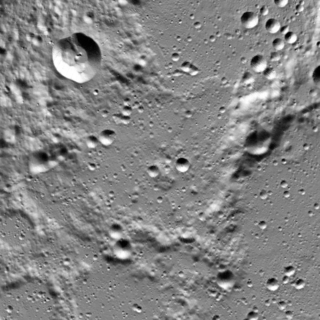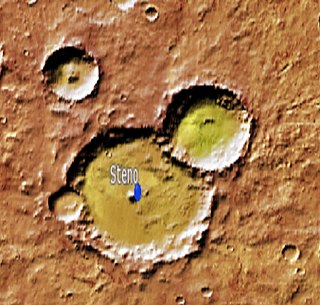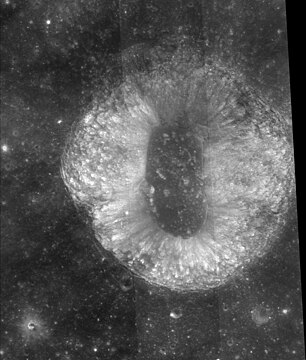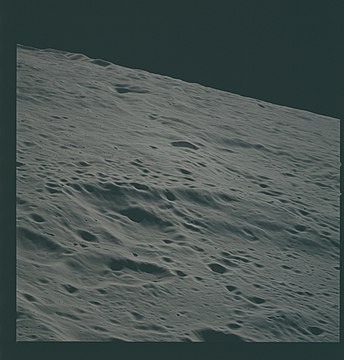
Planetary nomenclature, like terrestrial nomenclature, is a system of uniquely identifying features on the surface of a planet or natural satellite so that the features can be easily located, described, and discussed. Since the invention of the telescope, astronomers have given names to the surface features they have discerned, especially on the Moon and Mars. To standardize planetary nomenclature, the International Astronomical Union (IAU) was assigned in 1919 the task of selecting official names for features on Solar System bodies.

Canso is a Martian crater. It lies about 450 kilometres west of the Viking 1 lander, slightly northeast of Lunae Planum, and west of Chryse Planitia, in the Lunae Palus quadrangle. The crater is named after Canso, a fishing town in Nova Scotia. The name was officially adopted in 1988 by the International Astronomical Union's Working Group for Planetary System Nomenclature (IAU/WGPSN).

Dollond is a small lunar impact crater that is located in the central region of the Moon, to the north of the crater Abulfeda. It was named after British optician John Dollond. Due west of Dollond is Anděl. Dollond is circular and cone shaped, with a tiny floor at the midpoint of the sloping interior walls.

Curie is a large lunar impact crater, much of which lies on the far side of the Moon as seen from the Earth. The western rim projects into the near side of the Moon, as defined by the selenographic coordinate system. However the visibility of this formation depends on the effects of libration, so that it can be brought fully into view or completely hidden depending on the orientation of the Moon. When visible, however, it is seen nearly from the side, limiting the amount of detail that can be observed.

Chapais is a crater on Mars, named after the community of Chapais, Quebec, Canada. Chapais Crater is located at 22.6° south latitude, and 20.6° west longitude. Its diameter is 37.4 kilometres (23.2 mi).

Curie Crater is an impact crater in the Oxia Palus quadrangle of Mars, located at 29.1° N and 4.8° W. It is 114.1 km in diameter and was named after Pierre Curie, a French physicist-chemist (1859-1906).

Florey is a lunar impact crater on the lunar near side near the northern pole. Florey is directly adjacent to Byrd crater to the Southeast and Peary crater to the North. The crater is named after Australian scientist Howard Florey. The crater was named by the IAU in 2009.

Wells is an impact crater in the Eridania quadrangle on Mars. The crater was named after English writer H. G. Wells (1866–1946). The name was approved in 1973, by the International Astronomical Union (IAU) Working Group for Planetary System Nomenclature. Wells is the author of the science-fiction novel The War of the Worlds, depicting an invasion of earth by Martians.

Priestley is an impact crater in the Eridania quadrangle of Mars, located at 54.4°S latitude and 229.4°W longitude. It measures 41.9 kilometers in diameter and was named after English clergyman and scientist Joseph Priestley. The naming was approved by IAU's Working Group for Planetary System Nomenclature in 1973.

Steno is an impact crater on Mars, located in the Mare Australe quadrangle at 68.0°S latitude and 115.6°W longitude. It measures 106.9 kilometres (66.4 mi) in diameter and was named after Danish scientist Nicolas Steno (1638–1686). The name was approved in 1973, by the International Astronomical Union (IAU) Working Group for Planetary System Nomenclature.

Guest is a lunar impact crater that is located on the far side of the Moon, just west of the large crater Fermi and north of Izsak. Guest overlies an unnamed crater of similar size to the north, forming a pair. With its high albedo, the crater is probably young.













